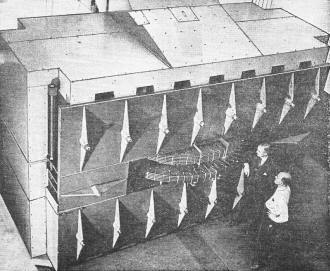World's Biggest Betatron
|
|
Betatron particle accelerators date back to 1935 with the one built by Max Steenbeck in Germany. The name is a portmanteau of "beta" + "electron," which is sort of a superfluous redundancy. This news piece is about the world's biggest betatron having been built, with dimensions of 9 feet high, 6 feet wide and 15 feet long, and 24,000 volt energizing coils. Strangely (it seems to me), the article interchanges the terms "xxx-volt electrons" and "xxx electron-volts. I suppose its fundamentally the same thing, but just unusual to see it that way. Note the robustness of the machine as required to rigidly contain such powerful magnetic forces. According to Wikipedia, an alternate name suggested for the betatron was "Außerordentlichehochgeschwindigkeitselektronenentwickelndesschwerarbeitsbeigollitron," meaning "Hard working by golly machine for generating extraordinarily high velocity electrons." (see Google translation) World's Biggest Betatron Biggest of its kind is the 100,000,000 volt betatron or electron accelerator constructed at the General Electric Research Laboratory in Schenectady, N.Y. The new machine gives out X-rays of a power never previously approached. These will penetrate a thickness of metal considerably greater than the rays from G-E's 2,000,000-volt industrial X-ray unit. But even more exciting are the possibilities that with the 100,000,000-volt electron stream that produces X-rays of the same energy we can produce other interesting forms of radiation. Located in a special building with concrete walls three feet thick, as a protection from the dangerous rays given off, the principal part of the betatron is a huge electromagnet, made of 130 tons of laminated silicon steel. It is 9 feet high, 6 feet wide and 15 feet long. In a rectangular opening passing through the magnet from front to back are the pole faces, 76 inches in diameter, surrounded by large coils of insulated 1-inch copper conductor. As electricity at 24,000 volts surges through these coils from a bank of condensers in an upstairs room, the magnet is energized, the intense magnetic field being concentrated in the horizontal space between the pole faces. Here is the heart of the machine - a doughnut-shaped vacuum tube of glass. The doughnut has an over-all diameter of 74 inches while the tube itself, of elliptical cross section, measures inside 8 inches horizontally and nearly 5 inches vertically. It is made of 16 sectors of molded and tempered pyrex glass, cemented together. The inner surface of this tube had to be made electrically conducting, so that it would not accumulate a charge that would upset the paths of the electrons within. This was accomplished by sandblasting the inner surfaces and then silvering them. Projecting into the doughnut at one point is an electron gun, consisting of a heated filament from which electrons are boiled off, to be given an initial impulse of several thousand volts to start them in their orbits inside the doughnut. The magnetic field holds them in a fixed circular orbit as they gain speed and energy on successive revolutions, gaining about 400 electron volts each trip. The machine operates on ordinary 60-cycle alternating current. Acceleration of the electrons is confined to the first quarter of each cycle, lasting 1/240th of a second during which the current goes from zero to its maximum in one direction. Then it goes back to zero, before building up in the opposite direction. If the electrons were allowed to remain in the tube during the second quarter cycle they would be slowed down again, so they are removed before this happens. Just as the end of the quarter cycle is reached, a pulse of current passes through two smaller auxiliary coils on the pole faces. This causes the electrons to spiral away from their orbit and to hit a tungsten target which they previously missed. This causes the generation of X-rays, which emerge from the doughnut in a beam which is 2 degrees in diameter when the machine is operated at full power. It may, however, be operated at a lower power, as the pulse may be applied at any time during the first quarter cycle. If, for example, it is done when they have made only 125,000 instead of the full 250,000 revolutions, they will have energies of only 50,000,000 electron volts. Or they may be taken out at any other stage so the device can produce X-rays from about 2,000,000 up to 100,000,000 volts. On one of the control panels is a unique instrument - a megavolt meter. A megavolt is a million volts, and the dial of this meter is graduated from one to 100 of these units. When the machine is operating at full power, this indicates 100,000,000 volts as casually as a small voltmeter might show 5 or 6 volts when used to test an automobile battery. A view of the world-beating betatron. The giant magnet coils protrude slightly from the front.
Posted May 19, 2021 |
|

